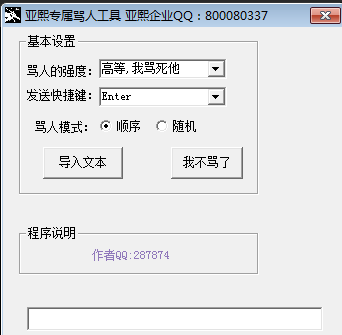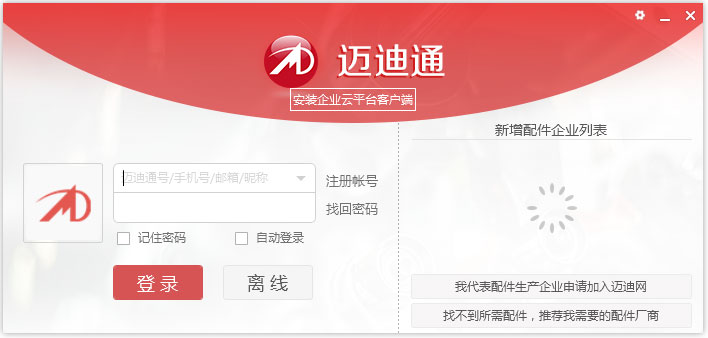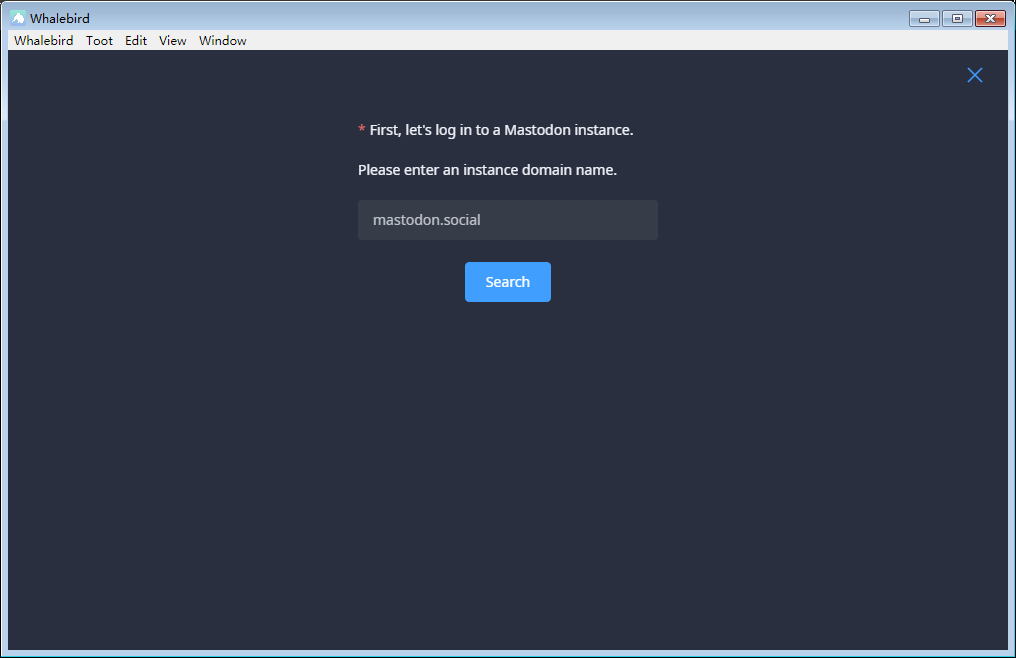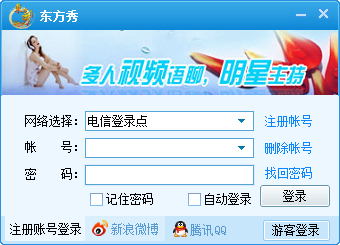Resource Access Based on Multiple Credentials
时间:2022-03-13 23:34
A collection of multiple?user?credentials?each associated with one of multiple different users is obtained at a device, and one or more of the multiple?user credentials?are verified. A determination is made as to whether access to a resource is permitted, by at least comparing the collection of multiple?user credentials?to a threshold combination of?user?credentials?to be satisfied to access the resource. An indication of whether access to the resource by a requesting?user?is permitted is returned or provided to another device.
BACKGROUND
As the use of computers and networks has increased, so too has the desire to restrict access to resources so that they can be accessed by only the appropriate users. Each?user?typically has his or her own?user?credentials?that he or she can provide in order to prove his or her identity and to indicate whether he or she is entitled to access a particular resource. Access to the particular resource is then permitted or denied based on the?user‘s identity. However, such reliance on a?user‘s?credentials?is not without its problems. One such problem is that this use of?user‘s?credentials?constrains designers on how they can restrict access to particular resources. This can lead to more rigid access control systems, and frustration on the part of both designers and users of computers.
SUMMARY
This Summary is provided to introduce a selection of concepts in a simplified form that are further described below in the Detailed Description. This Summary is not intended to identify key features or essential features of the claimed subject matter, nor is it intended to be used to limit the scope of the claimed subject matter.
In accordance with one or more aspects, a collection of multiple?user?credentials each associated with one of multiple different users is obtained at a device. One or more of the multiple?user?credentials?are verified, and the collection of multiple user?credentials?is compared to a threshold combination of?user?credentials?to be satisfied to access the resource. A determination is made, based on the comparing and the verifying, as to whether access to the resource is permitted, and an indication is provided of whether access to the resource by a requesting user?is permitted.
BRIEF DESCRIPTION OF THE DRAWINGS
The same numbers are used throughout the drawings to reference like features.
FIG. 1?illustrates an example system implementing the resource access based on multiple?credentials?in accordance with one or more embodiments.
FIG. 2?is a block diagram illustrating an example access control system in accordance with one or more embodiments.
FIG. 3?illustrates an example computing device implementing the resource access based on multiple?credentials?in accordance with one or more embodiments.
FIG. 4?is a flowchart illustrating an example process for resource access based on multiple?credentials?in accordance with one or more embodiments.
FIG. 5?illustrates an example computing device that can be configured to implement the resource access based on multiple?credentials?in accordance with one or more embodiments.
DETAILED DESCRIPTION
Resource access based on multiple?credentials?is discussed herein. When a?user requests access to a resource, a collection of multiple?user?credentials?from multiple different users is collected. A determination is then made, based on this collection of multiple?user?credentials, whether the requester is permitted to access the resource. The multiple?user?credentials?can include?user?credentials for the requester and/or?user?credentials?of other users.
References are made herein to symmetric key cryptography, public key cryptography and public/private key pairs. Although such key cryptography is well-known to those skilled in the art, a brief overview of such cryptography is included here to assist the reader. In public key cryptography, an entity (such as a?user, hardware or software component, a device, a domain, and so forth) has associated with it a public/private key pair. The public key can be made publicly available, but the entity keeps the private key a secret. Without the private key it is computationally very difficult to decrypt data that is encrypted using the public key. So, data can be encrypted by any entity with the public key and only decrypted by an entity with the corresponding private key. Additionally, a digital signature for data can be generated by using the data and the private key. Without the private key it is computationally very difficult to create a signature that can be verified using the public key. Any entity with the public key can use the public key to verify the digital signature by executing a suitable digital signature verification algorithm on the public key, the signature, and the data that was signed.
In symmetric key cryptography, on the other hand, a shared key (also referred to as a symmetric key) is known by and kept secret by the two entities. Any entity having the shared key is typically able to decrypt data encrypted with that shared key. Without the shared key it is computationally very difficult to decrypt data that is encrypted with the shared key. So, if two entities both know the shared key, each can encrypt data that can be decrypted by the other, but other entities cannot decrypt the data if the other entities do not know the shared key.
FIG. 1?illustrates an example system?100?implementing the resource access based on multiple?credentials?in accordance with one or more embodiments. System?100?includes a computing device?102?that can communicate with an access control service?104?and a resource?106?via a network?108. Network?108can be a variety of different networks, including the Internet, a local area network (LAN), a public telephone network, an intranet, other public and/or proprietary networks, combinations thereof, and so forth.
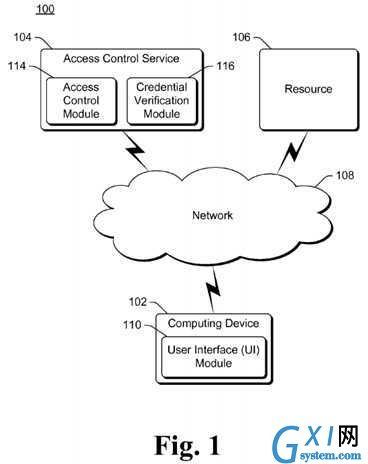
Computing device?102?can be a variety of different devices. For example, computing device?102?can be a desktop computer, a laptop or netbook computer, a mobile station, an entertainment appliance, a set-top box communicatively coupled to a display device, a television, a cellular or other wireless phone, a game console, an audio and/or video playback device, an automotive computer, and so forth. Thus, computing device?102?may range from a full resource device with substantial memory and processor resources (e.g., personal computers, game consoles) to a low-resource device with limited memory and/or processing resources (e.g., traditional set-top boxes, hand-held game consoles).
Computing device?102?includes a?user?interface (UI) module?110. UI module?110manages a?user?interface for device?102, including receiving?user?inputs from a user?of device?102?and displaying or otherwise presenting information to the?user of device?102.?User?inputs can be provided in a variety of different manners, such as by a?user?pressing one or more keys of a keypad or keyboard of device102, or pressing a particular portion of a touchpad or touchscreen of device?102. Touchscreen functionality can be provided using a variety of different technologies, such as through capacitive, surface acoustic wave, resistive, optical, strain gauge, dispersive signals, acoustic pulse, or other touchscreen technologies. The?user?input can also be provided in other manners via other types of sensors, such as audible inputs via a microphone or other audio sensor, other physical feedback input to the device (e.g., tapping any portion of device102?or another action that can be recognized by a motion detection component of device?102, such as shaking device?102, rotating device?102, etc.) via a motion or movement sensor, inputs via infrared sensors, inputs via light sensors, inputs via cameras or other image capture devices (e.g., fingerprint sensors), and so forth.
Additionally, UI module?110?can receive?user?inputs via another device or module. For example, one or more other modules of computing device?102, or devices coupled to or otherwise in communication with computing device?102, can receive?user?inputs and communicate the received?user?inputs to UI module?110. It should also be noted that?user?inputs can be received by UI module?110?(or another device or module) on behalf of the?user?without requiring a specific?user input. For example, a location of the?user?can be identified as a?user?input (e.g., using Global Positioning System (GPS) coordinates or other wireless technologies), data on a smartcard (e.g., in the?user‘s pocket) can be retrieved as a?user?input, and so forth.
In one or more embodiments, the current location of computing device?102and/or other information received on behalf of the?user?is identified or otherwise obtained with the?user‘s permission. A description of the information identified or otherwise obtained, how and/or why such information is identified or otherwise obtained, how such information is used by device?102, and the benefits of permitting such information to be identified or otherwise obtained can be displayed or otherwise presented to the?user. The?user?can then opt-in to having such information identified or otherwise obtained on his or her behalf. Alternatively, the?user?can be given the option to opt-out of using such information, and such information is identified or otherwise obtained on the?user‘s behalf unless the?user?opts-out of using such information. Accordingly, if the?user desires to not have the current location of device?102?identified and/or other information obtained on his or her behalf, the?user?can easily instruct device?102to not have such information identified or otherwise obtained.
In one or more embodiments, UI module?110?displays information on a screen of device?102. Such a screen can be implemented in a variety of different manners, such as using liquid crystal display (LCD) technology, plasma screen technology, image projection technology, and so forth. Alternatively, rather than including a screen, device?102?can generate one or more signals that are output to one or more other display devices which include a screen on which the information is displayed. In other embodiments, UI module?110?presents information in different manners, such as playing back audio content, physically moving device?102, and so forth.
A?user?of computing device?102?requests access to resource?106?by inputting, at computing device?102, a request to access resource?106. This request to access resource?106?can be input in a variety of different manners via UI module?110. Whether access to resource?106?is permitted in response to the?user?request is dependent at least in part on?user credentials?of multiple other users as discussed in more detail below. The?user?credentials?of the other users can be entered via computing device?102, or alternatively via another computing device (e.g., analogous to computing device?102).
Resource?106?can be a variety of different types of resources to which a?user?of computing device?102?might request access. Although a single resource?106?is illustrated in?FIG. 1, it is to be appreciated that system?100?can include multiple resources?106. Resource?106?can be a particular device, such as a particular computing device, a particular storage device (e.g., magnetic or optical disk drive), a particular input device (e.g., a scanner or camera, a microphone, a fax machine, etc.), and so forth. Resource?106?can also be an information resource. An information resource can be, for example, a service that is implemented on one or more computing devices. Such a service can be a network (e.g., a corporate LAN), a social network service, an online service (e.g., a merchant), and so forth. An information resource can also be, for example, a portion of a particular storage device (e.g., a file or folder on a disk).
Although resource?106?is illustrated as separate from computing device?102?and accessed via network?108, it is to be appreciated that resource?106?can take other forms. For example, resource?106?can be coupled directly to computing device?102?(e.g., via a wired or wireless connection). By way of another example, resource?106?can be computing device102?(e.g., the resource that a?user?is requesting access to is computing device?102?itself).
Access control service?104?determines whether a requesting?user?is permitted to access a resource?106. This determination is made based on multiple?user?credentials?of multiple different users, as discussed in more detail below. Access control service?104?can be implemented on one or more computing devices analogous to computing device?102.
Access control service?104?includes an access control module?114?and a credential verification module?116. Modules?114and?116?can be implemented on the same computing device and/or different computing devices. Additionally, each of modules?114?and?116?can be implemented on a single computing device or implemented across multiple computing devices. Generally, access control module?114?receives requests to access resources?106, and responds to those requests with an indication of whether the?user?requesting to access the resource?106?is permitted to do so. Credential verification module116?verifies multiple?credentials?received from multiple different users, and access control module?114?determines whether a requesting?user?is permitted to access the resource?106?based at least in part on the multiple?credentials?received from multiple different users.
FIG. 2?is a block diagram illustrating an example access control system?200?in accordance with one or more embodiments. Access control system?200?can implement, for example, an access control service?104?of?FIG. 1. Access control system200?includes an access control module?202?and credential verification module?204, analogous to access control module?114and credential verification module?116?of?FIG. 1, respectively.
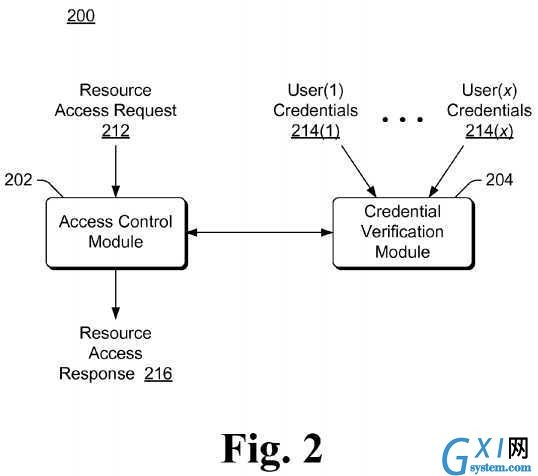
During operation, access control module?202?receives a?user?request?212?to access a resource. This?user?request can be received from, for example, a?user?of computing device?102?of?FIG. 1. In response to the?user?request, access control module?202?communicates with credential verification module?204, which verifies the multiple?user?credentials?214(1), . . . ,214(x) that module?204?obtains. Credential verification module?204?can receive?user?credentials?214?as part of the?user request, or alternatively can obtain?user?credentials?214?in other manners. For example, in response to a?user?request to access a resource, credential verification module?204?can request (e.g., via?user?interface module?110?of computing device102?of?FIG. 1) the?user?credentials?214?from the different users. It should be noted that at least part of credential verification module?204?can be implemented by a component or device that that collects a?user?credential (e.g., a fingerprint scanner can verify a scanned fingerprint and provide an indication to another portion of module?204?implemented on another device of whether the?user?credential is verified).
Credential verification module?204?provides to access control module?202?an indication of whether the obtained?user credentials?214?are verified. Access control module?202?uses this indication from credential verification module?204, as well as other information, to determine whether the?user?requesting access to the resource is permitted to access the resource. Access control module?202?then provides a resource access response?216?indicating whether the?user?requesting access to the resource is permitted to access the resource.
User?credentials?214?identify a particular?user, and a variety of different types of?user?credentials?214?can be used. For example,?user?credentials?214?can be a?user?id and password entered by the?user, a digital certificate and/or other identifying data obtained from a smartcard of the?user, biometric data entered by the?user, biometric data measured by the computing device (e.g., device?102?of?FIG. 1) or otherwise collected or captured by the computing device, a particular order in which biometric or other data is entered by the?user?(or otherwise is collected or captured), combinations thereof, and so forth. It should be noted that a variety of different biometric data can be captured or collected by the computing device, such as scans of a fingerprint, retina, face, veins, gait, and so forth of a?user. Different users can have the same type of user?credentials?214, or alternatively different types of?user?credentials?214.
User?credentials?214?can come from a variety of different sources. In one or more embodiments, different users input their respective?user?credentials?214?via the same computing device (e.g., computing device?102?of?FIG. 1). Alternatively, different users can input their respective?user?credentials?214?via different computing devices.
Credential verification module?204?verifies the received?user?credentials?214. The manner in which module?204?verifies the received?user?credentials?can vary based at least in part on the type of?user?credentials. In one or more embodiments, credential verification module?204?is programmed with or otherwise configured with an indication of the manner in which?user credentials?are to be verified. In other embodiments, a separate record or data store accessible to credential verification module?204?is maintained and identifies the manner in which?user?credentials?are to be verified for one or more resources.
In one or more embodiments, credential verification module?204?accesses a trusted data store (not shown) to obtain information used to verify the?credentials. For example, if a?user?credential?214?is a?user?id and password, then module?204can access a data store to obtain stored passwords and?user?ids, and verifies that the stored password and?user?id combination matches the?user?id and password provided as?user?credential?214. By way of another example, if a?user credential is a particular order in which biometric or other data is entered by the?user, then module?204?can access a data store to obtain the correct order and verify that the biometric or other data was entered in the correct order by the?user. By way of yet another example, the?user?credential?214?can be a data structure including an identifier of the?user?(such as a username or biometric measurement or characteristic) and the data structure can be digitally signed using the private key of a public/private key pair of the?user. Credential verification module?204?can verify the digital signature using the public key of the public/private key pair of the?user.
Additionally, in one or more embodiments credential verification module?204?uses multiple?user?credentials?from the same user?in order to verify the?user?credentials?for that?user. For example, in order to verify particular?user?credentials?module204?may require a?user?id, a password, and a digital certificate obtained from a smartcard of the?user. By way of another example, in order to verify particular?user?credentials?module?204?may require a?user?id, a password, and three fingerprints from the?user?input in the correct order (e.g., in the order of right thumb, left index finger, left thumb).
When using multiple?user?credentials?from the same?user?in order to verify the?user?credentials?for a?user, the particular combination or combinations that module?204?is to use to verify the?user?credentials?for the?user?can be identified in a variety of different manners (e.g., as discussed above with respect to the manner in which module?204?verifies the received user?credentials). Alternatively, different?user?credentials?can be associated with different validity probabilities or confidence levels, and different combinations of these?user?credentials?can be provided by a?user. Credential verification module?204verifies the?user?credentials?for that?user?if the combination of different?user?credentials?has at least a threshold validity probability or confidence level. The particular threshold validity probability or confidence level can be identified in a variety of different manners (e.g., as discussed above with respect to the manner in which module?204?verifies the received?user credentials).
In one or more embodiments, credential verification module?204?also uses information regarding the sources (e.g., computing devices) of the?user?credentials?in order to verify the?user?credentials?for a?user. This information regarding the sources can be characteristics of the sources, characteristics of a communication channel between the sources and access control system?200, and so forth. For example, the information regarding the sources can include the location of the source, a network that the source is coupled to, a measurement of the health of the source (e.g., how well a computing device is running, whether an up-to-date anti-virus program is running on a computing device, etc.), whether the source allows a?user to passively or actively respond to a challenge, and so forth. This information regarding the sources can be obtained from the sources themselves, or alternatively elsewhere (e.g., from a table or list maintaining the information). Credential verification module?204?can determine that the?user?credentials?for a?user?are verified in different manners based at least in part on the information regarding the sources. For example, module?204?can use different?user?credentials?for different source locations or depending on whether the source allows a?user?to passively or actively respond to a challenge, use different?credentials?for different networks to which a source may be coupled, and so forth.
Additionally, in one or more embodiments credential verification module?204?performs a risk assessment in verifying the?user credentials?for a?user. The risk assessment is an indication of the reliability of a particular source (e.g., computing device) and/or communication channel. Credential verification module?204?can impose more stringent constraints on verifying?user credentials?for sources deemed to be less reliable. For example, module?204?can determine that the?user?credentials?for a user?are verified in one manner if the?user?credentials?are received from a computing device on the same corporate network as access control system?200, and in a different manner (e.g., requiring a higher threshold validity probability or confidence level) if the?user?credentials?are received from a computing device coupled to access control system?200?via the Internet.
Access control module?202?determines whether the?user?from which resource access request?212?is received is permitted to access the desired resource based at least in part on the multiple?user?credentials?214. Module?202?can receive?user credentials?214?from credential verification module?204, or alternatively from another source (e.g., the same device or module from which credential verification module?204?received the?credentials). Alternatively, credential verification module204?can provide to access control module?202?identifiers or other indicators of the users for which?user?credentials?214?are provided rather than the?user?credentials?themselves.
Whether access to a particular resource is permitted is dependent on?user?credentials?214?and an indication of a threshold combination of?user?credentials?that is to be satisfied in order to access the particular resource. Each resource can have its own threshold combination of?user?credentials?that is to be satisfied in order to permit access to the resource, or access control module?202?can use the same threshold combination of?user?credentials?for multiple resources.
The threshold combination of?user?credentials?that is to be satisfied in order to access a particular resource can take one or more of a variety of different forms. In one or more embodiments, the threshold combination is a threshold number of?user credentials?214?from a threshold number of different users that are to be obtained and verified. For example, the threshold combination can be that at least three?user?credentials?214?from three different users are verified by credential verification module?204. In other embodiments, the threshold combination is that one or more users having?user?credentials?214?are to have particular?user?identifiers or be members of particular groups of users. A particular?user?identifier can be identified in different manners, such as being included as part of the?user?credentials?214?for that?user. A group that a?user?is a member of can be identified in different manners, such as being included as part of the?user?credentials?214?for that?user, being maintained in a separate list or record of users, and so forth.
It should be noted that the threshold combination of?user?credentials?can include that?user?credentials?for the?user?submitting resource access request?212?be included as one of?user?credentials?214. Thus, in order to be permitted access to a particular resource, the?user?requesting access to the resource is to provide his or her?user?credentials. Alternatively,?user credentials?for the?user?submitting resource access request?212?can be excluded from?user?credentials?214. Thus, a?user can request and be permitted access to a particular resource based on the?user?credentials?214?of other users rather than his or her own?user?credentials.
The threshold combination of?user?credentials?that is to be satisfied in order to access a particular resource can be identified in a variety of different manners. In one or more embodiments, access control module?202?is programmed with or otherwise configured with an indication of the threshold combination of?user?credentials. In other embodiments, each resource has an associated descriptor or other metadata identifying the threshold combination of?user?credentials. Access control module?202?obtains and uses this associated descriptor or other metadata to determine the threshold combination of user?credentials?for that resource.
In other embodiments, the threshold combination of?user?credentials?is identified based on a?user‘s?credentials. For example, the?user?credentials?(e.g., a digital certificate) of the?user?requesting access to the resource can include an indication of the threshold combination of?user?credentials. By way of another example, a separate record can be maintained of the threshold combination of?user?credentials?for different users. In yet other embodiments, the threshold combination of?user?credentials?is maintained in a separate record or database. This record or database can be accessed and used by access control module?202?to identify the threshold combination of?user?credentials?that is to be satisfied in order to access a particular resource.
Additionally, it should be noted that the threshold combination of?user?credentials?can be identified in a combination of multiple different manners. For example, the threshold combination of?user?credentials?that is to be satisfied in order to access a particular resource can be determined based on both a descriptor associated with the particular resource and based on the?credentials?of the?user?requesting access to the particular resource.
In one or more embodiments, the threshold combination of?user?credentials?can vary based on a risk assessment (similar to the risk assessment in verifying the?user?credentials?discussed above). In order to access a particular resource, different threshold combinations of?user?credentials?can be required for different risk assessments. For example,?user?credentials?of user?ids and passwords can be sufficient to satisfy the threshold combination if the?user?credentials?are received from a computing device on the same corporate network as access control system?200, but?user?credentials?of smartcards are needed to satisfy the threshold combination if the?user?credentials?are received from a computing device coupled to access control system?200?via the Internet. By way of another example,?user?credentials?of a single?user‘s smart card can be sufficient to satisfy the threshold combination if the?user?credentials?are received from a computing device in an area deemed secure by access control system?200, but?user?credentials?of four different users‘ smart cards are needed to satisfy the threshold combination if the?credentials?are received from a computing device not in an area deemed secure by access control system?200.
If the?user?credentials?214?are verified and the threshold combination of?user?credentials?are satisfied, then access control module?202?provides a resource access response?216?indicating that access to the resource by the?user?is permitted. However, if the?user?credentials?are not verified and/or the threshold combination of?user?credentials?are not satisfied, then access control module?202?provides a resource access response?216?indicating that access to the resource by the?user?is not permitted (is denied).
In one or more embodiments, if access to the resource by the?user?is not permitted, access control module?202?also provides an indication of why the threshold combination of?user?credentials?was not satisfied and/or what can be provided to access control system?200?in order for access to the resource by the?user?to be permitted. Information can then be displayed to a?user?informing the?user?of what additional?user?credentials?are to be provided to access control system?200in order to be granted access to the resource. For example, if the threshold combination to access a particular resource is verified?user?credentials?from three different users, and verified?user?credentials?from only two different users have been obtained, then access control module?202?can return an indication that verified?user?credentials?from one additional?user?are to be input in order to access the particular resource. The?user?can thus be presented with information informing him or her that he or she is to have one additional?user?input?user?credentials?for verification in order to access the particular resource.
Additionally, in one or more embodiments, resource access response?216?is provided to the device from which resource access request?212?was received (e.g., computing device?102?of?FIG. 1). Alternatively (or additionally), resource access response?216?can be provided to other devices or modules, such as the resource to which access is requested.
It should be noted that in one or more embodiments all?user?credentials?214?that are received are to be verified in order for access control module?202?to indicate that access to the requested resource is permitted. If one or more?user?credentials are not satisfied then access control module?202?provides a resource access response?216?indicating that access to the resource by the?user?is not permitted. Alternatively, access control module?202?can indicate that access to the resource by the?user?is permitted even if one or more?user?credentials?are not satisfied, so long as the threshold combination of?user resources is still satisfied. For example, assume that five?user?credentials?214?are obtained by credential verification module204?and only three of those five?user?credentials?214?are verified by module?204. If the threshold combination of?user resources is satisfied by three?user?credentials, then access control module?202?provides a resource access response?216indicating that access to the resource by the?user?is permitted.
Access control module?202?provides an indication of whether access to the requested resource is permitted. Another device or module (e.g., the resource itself) typically enforces this access based on the response?216?provided by access control module?202, either allowing the?user?requesting access to the resource to access the resource or preventing the?user requesting access to the resource from accessing the resource. Alternatively, access to the resource can be enforced by access control system?200.
FIG. 3?illustrates an example computing device?300?implementing the resource access based on multiple?credentials?in accordance with one or more embodiments. Computing device?300?includes a?user?interface (UI) module?304, a credential verification module?306, and an access control module?308. Computing device?300?is similar to computing device?102?of FIG. 1, and can be a variety of different computing devices analogous to computing device?102?of?FIG. 1. Computing device300?includes a?user?interface module?304, analogous to?user?interface module?110?of?FIG. 1.
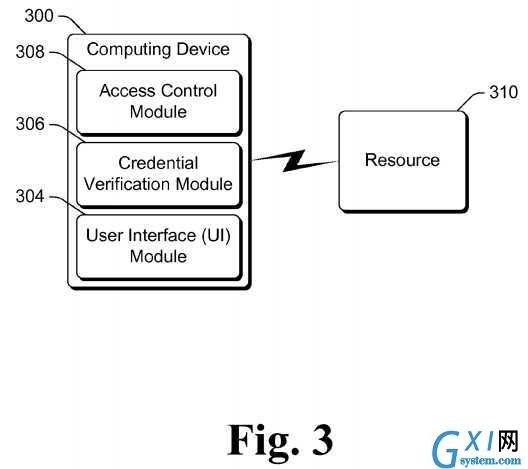
Computing device?300?also includes credential verification module?306?and access control module?308, analogous to credential verification module?204?and access control module?202?of?FIG. 2, respectively. Computing device?300?operates similar to computing device?102?of?FIG. 1, except that the credential verification and access determination performed by modules?306?and?308?is performed at computing device?300?rather than at a remote access control service. Accordingly, the access control service is provided by computing device?300?itself.
A?user?of computing device?300?can request access to a particular resource?310, analogous to resource?106?of?FIG. 1. Additionally, computing device?300?itself can be the resource?310?to which the?user?requests access.
FIG. 4?is a flowchart illustrating an example process?400?for resource access based on multiple?credentials?in accordance with one or more embodiments. Process?400?is carried out by a device or service, such as device?300?of?FIG. 3?or access control service?104?of?FIG. 1, and can be implemented in software, firmware, hardware, or combinations thereof. Process400?is shown as a set of acts and is not limited to the order shown for performing the operations of the various acts. Process?400?is an example process for resource access based on multiple?credentials; additional discussions of resource access based on multiple?credentials?are included herein with reference to different figures.
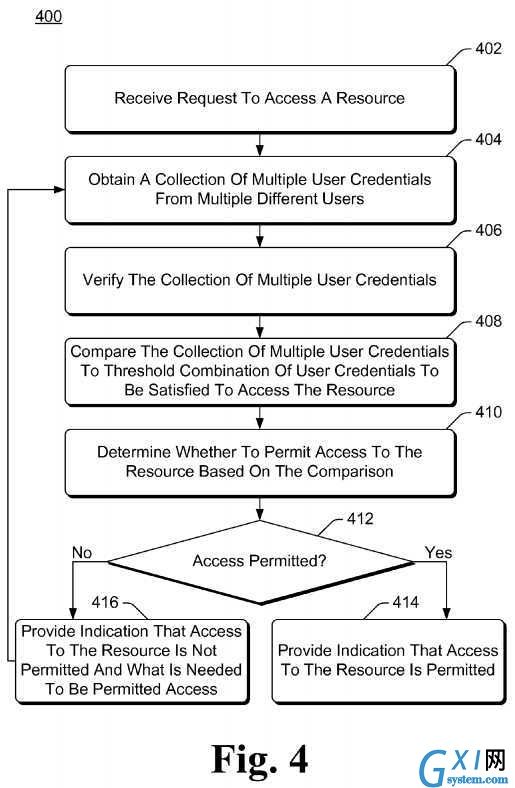
In process?400, a request to access a resource is received (act?402). This request is typically a request received from a user?of a particular computing device, although alternatively can be received from another component or module. Access to a variety of different resources can be requested as discussed above, including the computing device via which the?user inputs the request.
A collection of multiple?user?credentials?are obtained from multiple different users (act?404). A variety of different types of user?credentials?can be obtained from a variety of different sources as discussed above.
The collection of multiple?user?credentials?is verified (act?406). One or more of the multiple?user?credentials?in the collection are verified as discussed above.
The collection of multiple?user?credentials?is compared to a threshold combination of?user?credentials?that is to be satisfied in order to access the resource (act?408). This threshold combination of?user?credentials?can take a variety of different forms as discussed above, such as a threshold number of?user?credentials?and/or particular?user?identifiers that a?user?is to have and/or a group that a particular?user?is to be a member of Additionally, this threshold combination of?user?credentials can change based on a risk assessment of the sources of the?user?credentials?as discussed above.
A determination is made whether to permit access to the resource based on the comparison (act?410). This determination is also based at least in part on the verification performed in act?406?as discussed above.
Process?400?proceeds, based on whether access to the resource is permitted (act?412), as determined in act?410. If access to the resource is permitted, then an indication that access to the resource is permitted is provided (act?414). This indication can be provided to the?user?from which the request was received in act?402?(or the computing device being used by that?user), and/or to another device or module as discussed above.
However, if access to the resource is not permitted, then both an indication that access to the resource is not permitted and an indication of what is needed in order for access to be permitted is provided (act?416). These indication can be provided to the?user?from which the request was received in act?402?(or the computing device being used by that?user), and/or to another device or module as discussed above. Process?400?then returns to act?404?to obtain additional?credentials?to be verified in order to obtain access to the resource. Alternatively, if no additional?credentials?are obtained in act?404?(e.g., no additional?user?credentials?are provided by a?user), then process?400?ends without access to the resource being permitted.
The resource access based on multiple?credentials?discussed herein provides for a variety of different usage scenarios. For example, a particular?user?can request access to a particular service, but be allowed to access that particular service only if another?user?(e.g., a parent, a supervisor, etc.) indicates that such access is to be permitted. The other?user?can indicate that such access is to be permitted by providing his or her?user?credentials. Accordingly, the access control service permits the requesting?user?to access the particular service only if the?user?credentials?of the requesting?user?and the?user credentials?of the other?user?are provided to the access control service.
By way of another example, assume that a first?user?forgets his or her password to access a corporate network. The access control service can be configured so that a?user?is permitted to access the corporate network (e.g., and reset his or her password) if at least three other users that are verified as being permitted to access the corporate network vouch for the first?user. Accordingly, the first?user?can request access to the corporate network and have three co-workers provide their?user?credentials?on his behalf The access control service then permits the first?user?to access the corporate network with his or her?user?identifier (but without his or her password) if at least three co-workers provide their?user?credentials?to the access control service.
Continuing with this example, the access control service can be configured to employ risk assessment to determine whether the?user?is permitted to access the corporate network. For example, if the?user?is requesting access to the corporate network from a computing device on the corporate network, then the?user?is permitted to access the corporate network if at least three other users that are verified as being permitted to access the corporate network vouch for the first?user. However, if the?user?is requesting access to the corporate network from a computing device accessing the corporate network via the Internet then the?user?is not permitted to access the corporate network with at least three other users that are verified as being permitted to access the corporate network vouching for the first?user, but can access the corporate network if a?user?verified as a corporate security officer vouches for the first?user.
FIG. 5?illustrates an example computing device?500?that can be configured to implement the resource access based on multiple?credentials?in accordance with one or more embodiments. Computing device?500?can be, for example, computing device?102?of?FIG. 1, computing device?300?of?FIG. 3, or can implement access control service?104?of?FIG. 1.
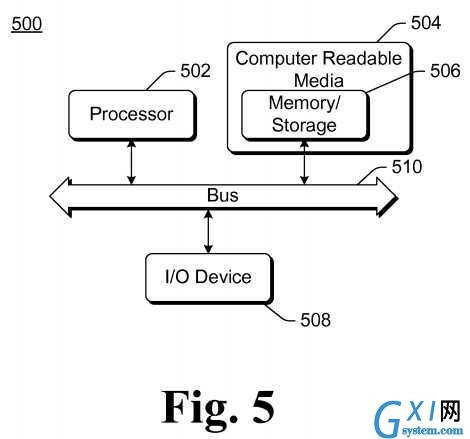
Computing device?500?includes one or more processors or processing units?502, one or more computer readable media504?which can include one or more memory and/or storage components?506, one or more input/output (I/O) devices?508, and a bus?510?that allows the various components and devices to communicate with one another. Computer readable media504?and/or one or more I/O devices?508?can be included as part of, or alternatively may be coupled to, computing device500. Bus?510?represents one or more of several types of bus structures, including a memory bus or memory controller, a peripheral bus, an accelerated graphics port, a processor or local bus, and so forth using a variety of different bus architectures. Bus?510?can include wired and/or wireless buses.
Memory/storage component?506?represents one or more computer storage media. Component?506?can include volatile media (such as random access memory (RAM)) and/or nonvolatile media (such as read only memory (ROM), Flash memory, optical disks, magnetic disks, and so forth). Component?506?can include fixed media (e.g., RAM, ROM, a fixed hard drive, etc.) as well as removable media (e.g., a Flash memory drive, a removable hard drive, an optical disk, and so forth).
The techniques discussed herein can be implemented in software, with instructions being executed by one or more processing units?502. It is to be appreciated that different instructions can be stored in different components of computing device?500, such as in a processing unit?502, in various cache memories of a processing unit?502, in other cache memories of device?500?(not shown), on other computer readable media, and so forth. Additionally, it is to be appreciated that the location where instructions are stored in computing device?500?can change over time. Furthermore, it should be noted that instructions can also be stored on other devices, such as a device that collects?user?credentials?(e.g., a device that collects a fingerprint can contain instructions that can be executed by processing unit?502?(or a processing unit or controller of the device) to verify the fingerprint).
One or more input/output devices?508?allow a?user?to enter commands and information to computing device?500, and also allows information to be presented to the?user?and/or other components or devices. Examples of input devices include a keyboard, a cursor control device (e.g., a mouse), a microphone, a scanner, and so forth. Examples of output devices include a display device (e.g., a monitor or projector), speakers, a printer, a network card, and so forth.
SRC=

